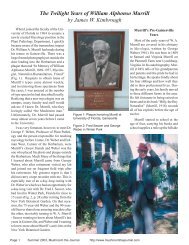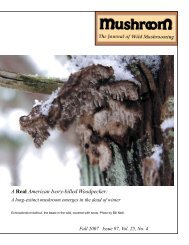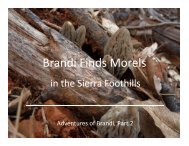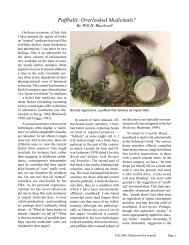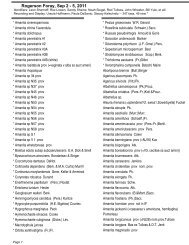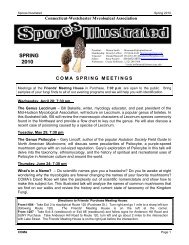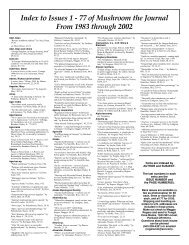Part One, by David Rose - Mushroom, the Journal of Wild ...
Part One, by David Rose - Mushroom, the Journal of Wild ...
Part One, by David Rose - Mushroom, the Journal of Wild ...
You also want an ePaper? Increase the reach of your titles
YUMPU automatically turns print PDFs into web optimized ePapers that Google loves.
William Alphonso Murrill: The Legend <strong>of</strong> <strong>the</strong> Naturalist<br />
<strong>by</strong> <strong>David</strong> W. <strong>Rose</strong><br />
He had a reputation as a suave<br />
and charming sou<strong>the</strong>rn gentleman, a<br />
parlor-room pianist and entertainer<br />
<strong>of</strong> European royalty. He could<br />
“put a name on” practically every<br />
mushroom he encountered in <strong>the</strong><br />
field and traveled three continents in<br />
search <strong>of</strong> new species, conducting<br />
exhaustive studies <strong>of</strong> herbarium<br />
collections. He expanded our<br />
knowledge <strong>of</strong> agarics, boletes and<br />
polypores, yet was reviled <strong>by</strong> certain<br />
taxonomists as an unregenerate<br />
“splitter” who slavishly followed<br />
<strong>the</strong> American Code <strong>of</strong> nomenclature<br />
promulgated <strong>by</strong> Nathaniel Lord<br />
Britton <strong>of</strong> <strong>the</strong> New York Botanical<br />
Garden. He styled himself “<strong>the</strong><br />
Naturalist” and wrote children’s<br />
books, associating with famous<br />
literary figures <strong>of</strong> his age such as<br />
John Burroughs and Rabindranath<br />
Tagore. William Alphonso Murrill<br />
stands at <strong>the</strong> beginning <strong>of</strong> twentieth<br />
century mycology as a seminal<br />
figure, and <strong>the</strong> complete story <strong>of</strong> his<br />
life has yet to be fully told. It is a<br />
story <strong>of</strong> a rise, fall, and remarkable<br />
rebirth, a grand tale with both comic<br />
and tragic aspects.<br />
Murrill was born on October<br />
13, 1869 near Lynchburg, Virginia<br />
where his parents operated a school<br />
for girls. He looked back on his<br />
happy childhood in his book Billy<br />
<strong>the</strong> Boy Naturalist (1918). His<br />
youthful scholarly bent led to studies<br />
in science, agriculture, mechanics,<br />
literature, and languages, earning<br />
two bachelor’s and a master’s degree<br />
in <strong>the</strong> process <strong>of</strong> choosing a career<br />
as a teacher. In autobiographical<br />
writings <strong>of</strong> later years, he revealed<br />
that he began seriously to think<br />
<strong>of</strong> himself as a naturalist while<br />
teaching at <strong>the</strong> Wesleyan Female<br />
Seminary in Staunton, Virginia in<br />
<strong>the</strong> 1890s. He <strong>the</strong>n entered Cornell<br />
University to study under George<br />
Atkinson, first collecting parasitic<br />
fungi for <strong>the</strong> Cornell herbarium<br />
and <strong>the</strong>n embarking on <strong>the</strong> study<br />
<strong>of</strong> polypores in 1898. Murrill<br />
had a penchant for romanticizing<br />
<strong>the</strong> early phase <strong>of</strong> his career as a<br />
teacher, and perhaps he was happier<br />
<strong>the</strong>n, for soon after his marriage<br />
to Edna Lee Lutrell in 1897 a son<br />
born to <strong>the</strong>m died in infancy. This<br />
tragedy undoubtedly wreaked a<br />
great emotional toll on <strong>the</strong> new<br />
parents. Murrill gained his doctoral<br />
degree in 1900, traveled to Paris to<br />
attend <strong>the</strong> International Botanical<br />
Congress, and <strong>the</strong>n relocated to<br />
New York City.<br />
William Alphonso Murrill, in his days<br />
as assistant director <strong>of</strong> <strong>the</strong> New York<br />
Botanical Gardens<br />
The New York Botanical<br />
Garden, under <strong>the</strong> directorship <strong>of</strong><br />
Nathaniel Lord Britton, was fast<br />
becoming a center <strong>of</strong> leadership<br />
in botanical science at century’s<br />
turn. Murrill, however, did not step<br />
into <strong>the</strong> ranks <strong>of</strong> NYBG botanists<br />
at first; he continued his teaching<br />
career as a biology teacher at <strong>the</strong><br />
near<strong>by</strong> DeWitt Clinton High School<br />
in <strong>the</strong> Bronx. Through <strong>the</strong> Torrey<br />
Botanical Club he met Lucien<br />
Marcus Underwood and began<br />
publication <strong>of</strong> a series <strong>of</strong> articles<br />
“Polyporaceae <strong>of</strong> North America”<br />
in <strong>the</strong> Torrey club’s bulletin. When<br />
Franklin Sumner Earle resigned<br />
his position as staff mycologist at<br />
<strong>the</strong> Garden in 1904, Dr. Britton, a<br />
Torrey club stalwart, hired Murrill<br />
to replace him as Assistant Curator.<br />
This was a defining moment in his<br />
life – <strong>the</strong> moment <strong>the</strong> “naturalist”<br />
embarked on his career as a fullfledged<br />
pr<strong>of</strong>essional “mycologist.”<br />
Murrill’s experience at <strong>the</strong><br />
Garden was multi-faceted. He<br />
immediately began to build <strong>the</strong><br />
mycological collections and<br />
continued comparative studies<br />
<strong>of</strong> basidiomycetes, especially<br />
agarics and polypores. Britton soon<br />
promoted him to Acting Director,<br />
<strong>the</strong>n Assistant Director, effectively<br />
placing him second in command<br />
<strong>of</strong> <strong>the</strong> whole Garden. These<br />
appointments were a measure <strong>of</strong> <strong>the</strong><br />
Director’s confidence in Murrill,<br />
and <strong>the</strong>y carried a certain distinction<br />
but were fraught with <strong>the</strong> anxiety<br />
<strong>of</strong> serving closely <strong>the</strong> punctilious<br />
Dr. Britton and his overbearing<br />
wife, <strong>the</strong> bryologist Elizabeth<br />
Gertrude Britton. Murrill eventually<br />
ran afoul <strong>of</strong> <strong>the</strong>m both. For <strong>the</strong><br />
moment, however, his stature as a<br />
mycologist soared. When chestnut<br />
trees in <strong>the</strong> near<strong>by</strong> Bronx Zoo<br />
<strong>Mushroom</strong>, <strong>the</strong> <strong>Journal</strong> <strong>of</strong> <strong>Wild</strong> <strong>Mushroom</strong>ing http://www.mushroom<strong>the</strong>journal.com Page 1
egan dying en masse from an<br />
unknown canker in 1904, Murrill<br />
identified <strong>the</strong> fungal culprit as <strong>the</strong><br />
pyrenomycete Diapor<strong>the</strong> parasitica<br />
(now Cryphonectria parasitica). He<br />
went on to advise state governments<br />
(particularly Pennsylvania) and<br />
forest preserves such as <strong>the</strong> Biltmore<br />
Estate <strong>of</strong> George W. Vanderbilt<br />
about <strong>the</strong> protection <strong>of</strong> stands <strong>of</strong><br />
American chestnut trees from <strong>the</strong><br />
destructive fungus. By 1950 over 9<br />
million acres <strong>of</strong> chestnut trees were<br />
decimated <strong>by</strong> <strong>the</strong> fungal pathogen<br />
that Murrill first identified at <strong>the</strong><br />
century’s turn.<br />
In a sense, William Murrill’s<br />
most visible legacy is Mycologia,<br />
<strong>the</strong> premier journal <strong>of</strong> mycological<br />
science in North America. In 1908<br />
<strong>the</strong> New York Botanical Garden’s<br />
Board <strong>of</strong> Scientific Directors<br />
authorized not only a feasibility<br />
study for <strong>the</strong> journal but authorized<br />
experiments to reproduce<br />
<strong>the</strong>rein full-color illustrations<br />
<strong>of</strong> mushrooms. Murrill and <strong>the</strong><br />
Garden issued <strong>the</strong> first number <strong>of</strong><br />
Mycologia in January 1909, and<br />
it featured color reproductions <strong>of</strong><br />
fungi, leading <strong>the</strong> way to what has<br />
become a standard <strong>of</strong> macroscopic<br />
identification <strong>of</strong> mushrooms in<br />
published guidebooks to this day.<br />
He continued as editor <strong>of</strong> <strong>the</strong><br />
journal until his resignation from<br />
<strong>the</strong> Garden in 1924.<br />
William Murrill was an<br />
inveterate traveler and hunter <strong>of</strong><br />
mushrooms. He collected fungi<br />
throughout <strong>the</strong> nor<strong>the</strong>astern United<br />
States from Maine to Florida and<br />
also found time for trips to <strong>the</strong><br />
Caribbean, Mexico, and Europe as<br />
well as <strong>the</strong> Pacific coast where he<br />
lunched with Lu<strong>the</strong>r Burbank. His<br />
wife accompanied him on some<br />
excursions to paint illustrations<br />
<strong>of</strong> <strong>the</strong> fungi he collected. He was<br />
always fond <strong>of</strong> hunting mushrooms<br />
in his native Virginia. His travels<br />
to Europe usually involved<br />
examinations <strong>of</strong> herbarium<br />
collections; one such trip in 1906<br />
took him to herbaria at Trento<br />
(Italy), Paris, Berlin, Stockholm,<br />
Copenhagen, Uppsala, Leiden, and<br />
<strong>the</strong> Royal Botanic Garden at Kew,<br />
England. Murrill established an<br />
enduring relationship with Europe’s<br />
foremost amateur mycologist,<br />
Giacomo Bresadola. In a personal<br />
journal entry dated August 8, 1913<br />
he jotted <strong>the</strong> following notes about<br />
his visit to “<strong>the</strong> Curate”, as he called<br />
<strong>the</strong> Abbe Bresadola:<br />
“Went to Villa Salvadori met<br />
<strong>by</strong> Baron, a small ordinary kindly<br />
man who had servant take me to<br />
Curate’s house down at village<br />
below. Found … curate & Baron[‘s]<br />
pretty little daughters in garden<br />
getting fl[ower]s. He greeted me<br />
cordially, introduced me & took<br />
me into reception room & drank<br />
each o<strong>the</strong>r’s health & talked in<br />
German. Free & easy. Strong &<br />
stout but not fat. Self-confident in<br />
his vast knowledge <strong>of</strong> fungi & has a<br />
large collection at Trient. Saccardo<br />
has few poly[pore]s. Bres[adola]<br />
did not give him <strong>the</strong> rare ones. We<br />
journeyed back to his dejeuner at<br />
11 picking fungi & talking. The<br />
little girls meanwhile bringing <strong>the</strong>ir<br />
baskets with spec[imen]s for him to<br />
see.” 1<br />
Murrill admired Bresadola’s<br />
work (and appointed him an<br />
associate editor <strong>of</strong> Mycologia)<br />
but observed that he lacked<br />
attentiveness to North American<br />
species. In <strong>the</strong> same personal journal<br />
Murrill commented, “It is certainly<br />
true that many forms here are same<br />
as ours. Probably <strong>the</strong> forms among<br />
conifers in [North America] are<br />
more like <strong>the</strong>se. But our forms are<br />
not sufficiently appreciated in <strong>the</strong>ir<br />
differences... Bres[adola] makes<br />
a good deal <strong>of</strong> spores (not form)<br />
& when same he throws rest in. It<br />
is easy to understand how in dried<br />
spec[imen]s … species might in this<br />
way be confused. Be careful <strong>the</strong>n<br />
about allied species when reading<br />
after him. His self-confidence,<br />
too, is in <strong>the</strong> way <strong>of</strong> investigation.<br />
He knows all <strong>the</strong> Europ[ean]<br />
poly[pore]s. In many varieties he<br />
says. Believe Bres[adola] regarding<br />
lit[erature] &c, &c but beware <strong>of</strong><br />
lumping species & geographical<br />
groups.” Murrill elsewhere noted<br />
caustically <strong>of</strong> European collectors,<br />
“To <strong>the</strong> Swede or <strong>the</strong> German,<br />
Kew is a very foreign country and<br />
America is <strong>of</strong>f <strong>the</strong> map!” 2<br />
The year 1915 was a watershed<br />
year for Murrill. On <strong>the</strong> heels <strong>of</strong><br />
his publication <strong>of</strong> <strong>the</strong> monographs<br />
Nor<strong>the</strong>rn Polypores and American<br />
Boletes and <strong>the</strong> acquisition <strong>of</strong><br />
Lucien Marcus Underwood’s fungus<br />
collection for <strong>the</strong> Garden in 1914,<br />
Murrill issued Sou<strong>the</strong>rn Polypores,<br />
Western Polypores, and Tropical<br />
Polypores, all self-published in<br />
1915. Though he continued to<br />
make regular contributions on <strong>the</strong><br />
taxonomy <strong>of</strong> hymenomycetes to<br />
North American Flora, Mycologia,<br />
and o<strong>the</strong>r Garden publications, it<br />
is perhaps a measure <strong>of</strong> Britton’s<br />
waning support for his work that<br />
“<strong>the</strong> Naturalist” was faced with<br />
publishing five books on poroid<br />
fungi in rapid succession at his own<br />
expense. Yet Murrill saw himself<br />
as a committed educator with a<br />
public audience and followed<br />
<strong>the</strong>se treatises with Edible and<br />
Poisonous <strong>Mushroom</strong>s in 1916,<br />
accompanied <strong>by</strong> an enormous wall<br />
chart with color illustrations <strong>of</strong><br />
common mushrooms taken from<br />
his Mycologia reproductions. His<br />
interest in writing popular books<br />
<strong>Mushroom</strong>, <strong>the</strong> <strong>Journal</strong> <strong>of</strong> <strong>Wild</strong> <strong>Mushroom</strong>ing http://www.mushroom<strong>the</strong>journal.com Page 2
egan to tip <strong>the</strong> scale over technical<br />
publications as he went on to<br />
publish Three Young Crusoes (1918)<br />
dedicated to journalist Dorothy Dix,<br />
Billy <strong>the</strong> Boy Naturalist (1918),<br />
The Natural History <strong>of</strong> Staunton,<br />
Virginia (1919), and The Naturalist<br />
in a Boarding School (1919).<br />
Though <strong>the</strong>se latter works<br />
have inspired <strong>the</strong> work <strong>of</strong> some<br />
literary naturalists <strong>of</strong> recent times<br />
(Annie Dillard cites William<br />
Murrill as a source <strong>of</strong> inspiration<br />
in her Pilgrim at Tinker Creek), <strong>the</strong><br />
writing does not hold up very well<br />
today. Much <strong>of</strong> it seems forced,<br />
trivial, and even immature. There<br />
was something else at work here. In<br />
a certain way Murrill saw himself<br />
as a poet or artist, but he was a poet<br />
trying unsuccessfully to escape <strong>the</strong><br />
skin <strong>of</strong> a naturalist and mycologist.<br />
He peppered his popular writings<br />
with quotations from Wordsworth,<br />
Shelley, Keats, Tennyson, Emerson,<br />
and Ruskin, but in <strong>the</strong> meantime,<br />
back at his day job, he fought a<br />
losing battle over technical points<br />
<strong>of</strong> nomenclature and taxonomy with<br />
his strait-laced boss at <strong>the</strong> Garden,<br />
Dr. Britton.<br />
The American Code <strong>of</strong><br />
Botanical Nomenclature rigidly<br />
insisted on priority <strong>of</strong> names,<br />
and Murrill grew entangled in<br />
arguments with Britton about <strong>the</strong><br />
names <strong>of</strong> fungi. There are scores<br />
<strong>of</strong> examples, but <strong>the</strong> most striking<br />
and anachronistic to amateur<br />
mycologists today may be his use<br />
<strong>of</strong> “Venenarius” as a replacement<br />
for <strong>the</strong> genus Amanita. This usage<br />
was flatly rejected (or at least<br />
ignored) <strong>by</strong> <strong>the</strong> bulk <strong>of</strong> American<br />
mycologists, some <strong>of</strong> whom<br />
believed Britton’s American Code<br />
no better than a cranky, self-serving<br />
ploy to obfuscate taxonomic<br />
logic and upset nomenclatural<br />
reasonableness. On <strong>the</strong> o<strong>the</strong>r hand,<br />
Murrill well understood some <strong>of</strong> <strong>the</strong><br />
advantages in Britton’s <strong>the</strong>oretical<br />
position (e.g. single starting<br />
point) and, moreover, realized<br />
himself <strong>the</strong> need for smaller, more<br />
natural genera in <strong>the</strong> taxonomy <strong>of</strong><br />
basidiomycetes; yet he gained <strong>the</strong><br />
unfortunate reputation <strong>of</strong> being a<br />
“splitter”. He must have recognized<br />
<strong>the</strong> frustrations he provoked in<br />
certain traditionalists, for in 1918<br />
he published a comparative guide<br />
to polypore genera, Murrill’s and<br />
Saccardo’s Names <strong>of</strong> Polypores<br />
Compared. When <strong>the</strong> tally was<br />
complete, Saccardo had recognized<br />
20 genera <strong>of</strong> polypores whereas<br />
Murrill had more than tripled this<br />
with a grand total <strong>of</strong> 71! Despite<br />
his reputation as a splitter, many<br />
<strong>of</strong> Murrill’s new genera have held<br />
up and some have proven very<br />
useful to succeeding generations <strong>of</strong><br />
mycologists.<br />
The Garden had authorized<br />
Murrill’s first three European<br />
journeys in 1906, 1910, and 1913,<br />
but it was <strong>the</strong> fourth, in 1918,<br />
that ultimately led to a falling<br />
out with Nathaniel Britton and a<br />
tragic rupture in his career. On this<br />
particular voyage Murrill failed to<br />
return to New York as planned, and<br />
after an alarming amount <strong>of</strong> time<br />
with no word from him, he was<br />
considered missing. The Garden<br />
contacted European museums,<br />
herbaria, and his known associates,<br />
but no one knew his whereabouts.<br />
He finally returned to <strong>the</strong> Bronx<br />
months later with <strong>the</strong> report that<br />
he had been hospitalized for a<br />
kidney condition in a small French<br />
town and was actually near death<br />
with no means <strong>of</strong> outside contact<br />
for many weeks. He suffered from<br />
a polycystic kidney problem for<br />
<strong>the</strong> balance <strong>of</strong> his life. 3 The Board<br />
<strong>of</strong> Scientific Directors noted his<br />
hospitalization in June 1918 and<br />
return to work in December and<br />
in January 1919 also noted his<br />
“appointment” to <strong>the</strong> position <strong>of</strong><br />
“Supervisor <strong>of</strong> Public Instruction.”<br />
This appointment, at a considerable<br />
reduction in salary, was in reality a<br />
serious demotion and crushing blow<br />
to his self-esteem.<br />
Whe<strong>the</strong>r or not <strong>the</strong> unexplained<br />
absence was actually <strong>the</strong> proximate<br />
cause <strong>of</strong> <strong>the</strong> demotion, Murrill’s<br />
career now took a downward<br />
trajectory. In 1920 he made a<br />
request to <strong>the</strong> Director-in-Chief<br />
for an extended, but partial, leave<br />
<strong>of</strong> absence <strong>of</strong> one day per week.<br />
Britton flatly denied Murrill’s<br />
request. In our more liberal age<br />
<strong>of</strong> <strong>the</strong> Americans with Disabilities<br />
Act we may tend to interpret such<br />
treatment as a species <strong>of</strong> cruelty,<br />
but <strong>the</strong> requested alteration in<br />
<strong>the</strong> customary work schedule<br />
was a total aberration in Britton’s<br />
worldview. Murrill plugged away<br />
at his new position, which largely<br />
entailed a grueling round <strong>of</strong> lectures<br />
and exhibits, both at <strong>the</strong> Garden<br />
and on <strong>the</strong> road. He administered<br />
a five-week exhibition on plants<br />
used in architectural design at <strong>the</strong><br />
Metropolitan Museum <strong>of</strong> Art in<br />
New York, lectured on <strong>the</strong> history<br />
and botany <strong>of</strong> <strong>the</strong> lotus at <strong>the</strong><br />
Chicago Art Institute, and talked<br />
endlessly about <strong>the</strong> fungi to garden<br />
clubs and Girl Scout troops.<br />
Mycology remained his<br />
constant passion. Pr<strong>of</strong>essionally,<br />
he represented <strong>the</strong> Garden at a<br />
meeting <strong>of</strong> plant pathologists<br />
and Connecticut farm bureau<br />
agents in 1919 and attended<br />
a conference <strong>of</strong> <strong>the</strong> American<br />
Phytopathological Society on home<br />
territory in Staunton, Virginia in<br />
1920. He found great pleasure<br />
and camaraderie in an amateur<br />
<strong>Mushroom</strong>, <strong>the</strong> <strong>Journal</strong> <strong>of</strong> <strong>Wild</strong> <strong>Mushroom</strong>ing http://www.mushroom<strong>the</strong>journal.com Page 3
mycological club he established<br />
that same year – <strong>the</strong> Yama Farms<br />
Mycological Club. Yama Farms<br />
was a Catskill resort about 20<br />
miles west <strong>of</strong> Poughkeepsie, New<br />
York, a watering hole for <strong>the</strong> rich<br />
and famous. Here Murrill met John<br />
Burroughs, <strong>the</strong> Nobel Prize-winning<br />
Bengali poet Rabindranath Tagore,<br />
and members <strong>of</strong> <strong>the</strong> Dupont family<br />
whom he encouraged in mushroom<br />
collecting and identification. With<br />
great affection he installed John<br />
Burroughs as “Honorary President”<br />
<strong>of</strong> <strong>the</strong> club. Murrill dedicated his<br />
remaining energies in <strong>the</strong> activities<br />
<strong>of</strong> <strong>the</strong> Yama Farms club for <strong>the</strong> next<br />
three years<br />
Amanita murrillana, named after W. A.<br />
Murrill<br />
Henry Gleason, <strong>the</strong> plant<br />
ecologist who succeeded Murrill<br />
as Assistant Director at <strong>the</strong> Garden,<br />
tells a revealing story about his<br />
touchy relations with <strong>the</strong> Brittons.<br />
Gleason reported that from 1919<br />
to 1923 “nothing that Murrill did<br />
could satisfy Britton.” Mrs. Britton<br />
one day stormed <strong>of</strong>f to her husband<br />
with an item taken from <strong>the</strong> Bronx<br />
Home News, a local paper, which<br />
quoted Murrill saying that “<strong>the</strong><br />
shimmy dance was originated <strong>by</strong><br />
goldfish, because he had noticed<br />
that his goldfish were doing <strong>the</strong><br />
shimmy all day long.” This sent<br />
<strong>the</strong> Victorian sensibilities <strong>of</strong> Mrs.<br />
Britton into paroxysm, and Dr.<br />
Britton would have fired Murrill<br />
on <strong>the</strong> spot but lacked <strong>the</strong> authority<br />
for summary dismissal. 4 Murrill<br />
survived this trivial incident, but<br />
continued on a downward spiral <strong>of</strong><br />
nervous prostration and depression.<br />
Marital and financial problems<br />
compounded his decline. His wife<br />
moved away, never to return;<br />
<strong>the</strong>ir marriage ended in divorce.<br />
Exasperated with <strong>the</strong> Garden and<br />
with life, he quietly removed to<br />
Virginia. He bore eloquent but<br />
circumspect witness to his midlife<br />
crisis in his Autobiography<br />
(1945) when he wrote: “In August,<br />
1924, <strong>the</strong> Naturalist tendered his<br />
resignation and left <strong>the</strong> Garden<br />
after laboring <strong>the</strong>re for twenty<br />
years. The gilded net had finally so<br />
enmeshed him that little time was<br />
left for research and <strong>the</strong> long grind<br />
had worn him down.” 5 Dejected,<br />
depressed, and physically exhausted<br />
Murrill moved back to Virginia,<br />
and with Henry <strong>David</strong> Thoreau<br />
in mind, he built himself a cabin<br />
in <strong>the</strong> woods to seek rejuvenation<br />
through <strong>the</strong> natural world. He was<br />
hospitalized intermittently and was<br />
reportedly seen working as a day<br />
laborer. It seemed his mycological<br />
career was finished. Curtis Gates<br />
Lloyd, <strong>the</strong> acerbic author <strong>of</strong><br />
Mycological Notes, commented<br />
with an ironic gibe at Nathaniel<br />
Britton, “There is universal regret<br />
among mycologists…that Dr.<br />
Murrill has severed his connections<br />
with New York. Everyone likes<br />
Dr. Murrill, he is such a polished,<br />
affable gentleman and he would<br />
be an ideal head to such an<br />
institution.” 6 Murrill gravitated<br />
toward Florida and decided to move<br />
fur<strong>the</strong>r south. The Naturalist, once<br />
a world-renown mycologist, now<br />
preferred to drop out completely<br />
and settle in a Florida backwater.<br />
He may never have re-entered <strong>the</strong><br />
world <strong>of</strong> mycology were it not for a<br />
chance meeting on a highway south<br />
<strong>of</strong> Gainesville. Dr. George Weber <strong>of</strong><br />
<strong>the</strong> University <strong>of</strong> Florida, sometime<br />
in 1926, happened to recognize an<br />
unshaven, dirty, and disoriented man<br />
playing classical music on a piano<br />
in a crowded pavilion <strong>of</strong> <strong>the</strong> Tin<br />
Can Tourist Camp <strong>of</strong> Gainesville,<br />
Florida. The man at <strong>the</strong> piano was<br />
William Alphonso Murrill. 7<br />
This is part 1 <strong>of</strong> a 2-part<br />
article on <strong>the</strong> life <strong>of</strong> William A.<br />
Murrill. <strong>Part</strong> 2 will appear in<br />
<strong>the</strong> next issue <strong>of</strong> <strong>Mushroom</strong>: The<br />
<strong>Journal</strong> <strong>of</strong> <strong>Wild</strong> <strong>Mushroom</strong>ing.<br />
<strong>David</strong> W. <strong>Rose</strong>, 3 December 2002<br />
Endnotes:<br />
1<br />
William Alphonso Murrill<br />
Records, 1903-1957, LuEs<strong>the</strong>r T.<br />
Mertz Library, New York Botanical<br />
Garden<br />
<strong>Mushroom</strong>, <strong>the</strong> <strong>Journal</strong> <strong>of</strong> <strong>Wild</strong> <strong>Mushroom</strong>ing http://www.mushroom<strong>the</strong>journal.com Page 4<br />
2<br />
ibid<br />
3<br />
Information <strong>of</strong> James W.<br />
Kimbrough to author, 26 January<br />
2000<br />
4<br />
Henry Gleason A. Short and<br />
Simple Annals, unpublished mss.,<br />
p. 288<br />
5<br />
Murrill, William A.<br />
Autobiography (1945) p. 137<br />
6<br />
Lloyd, Curtis Gates<br />
Mycological Notes (1924) 7:1342<br />
7<br />
Information <strong>of</strong> James W.<br />
Kimbrough, 26 January 2000



